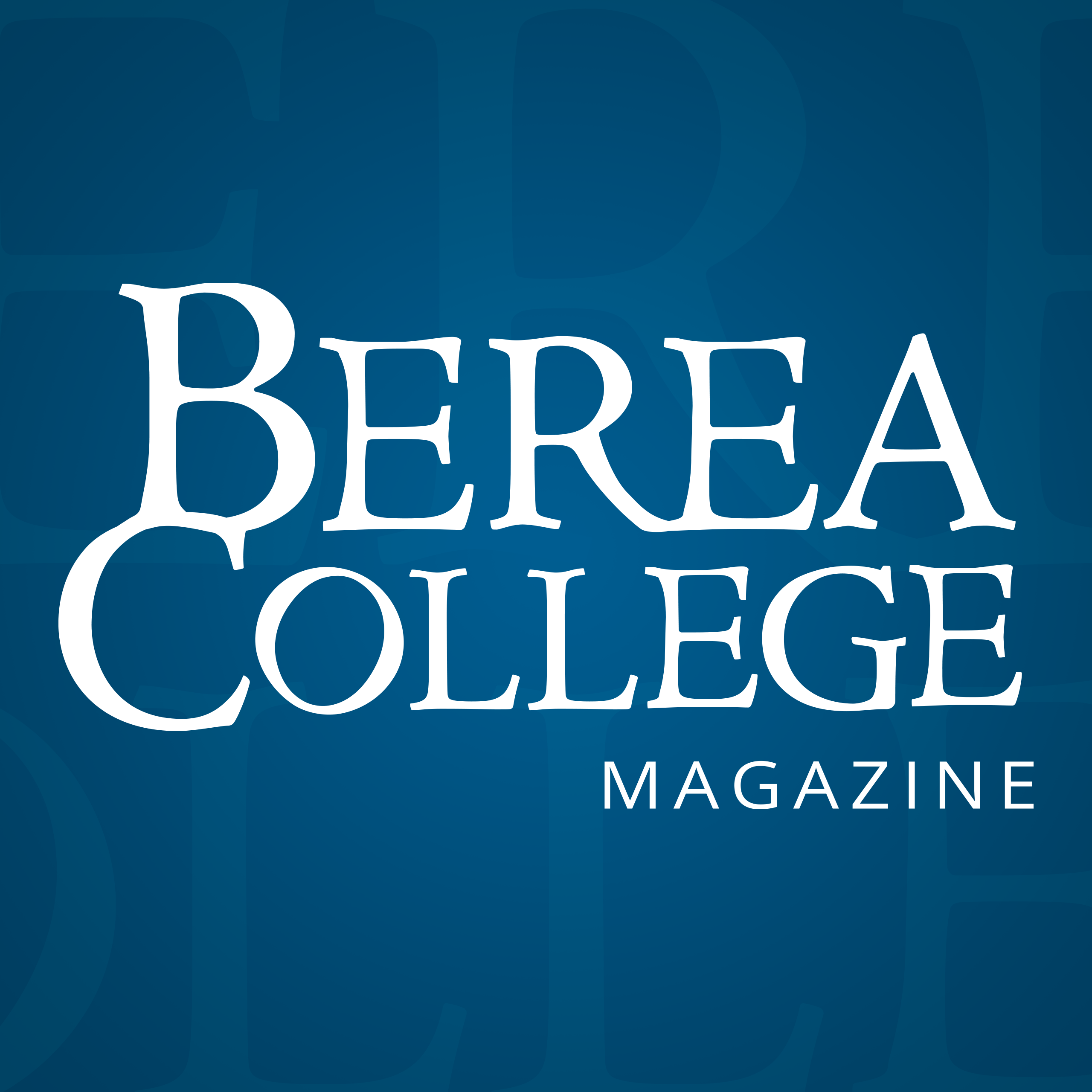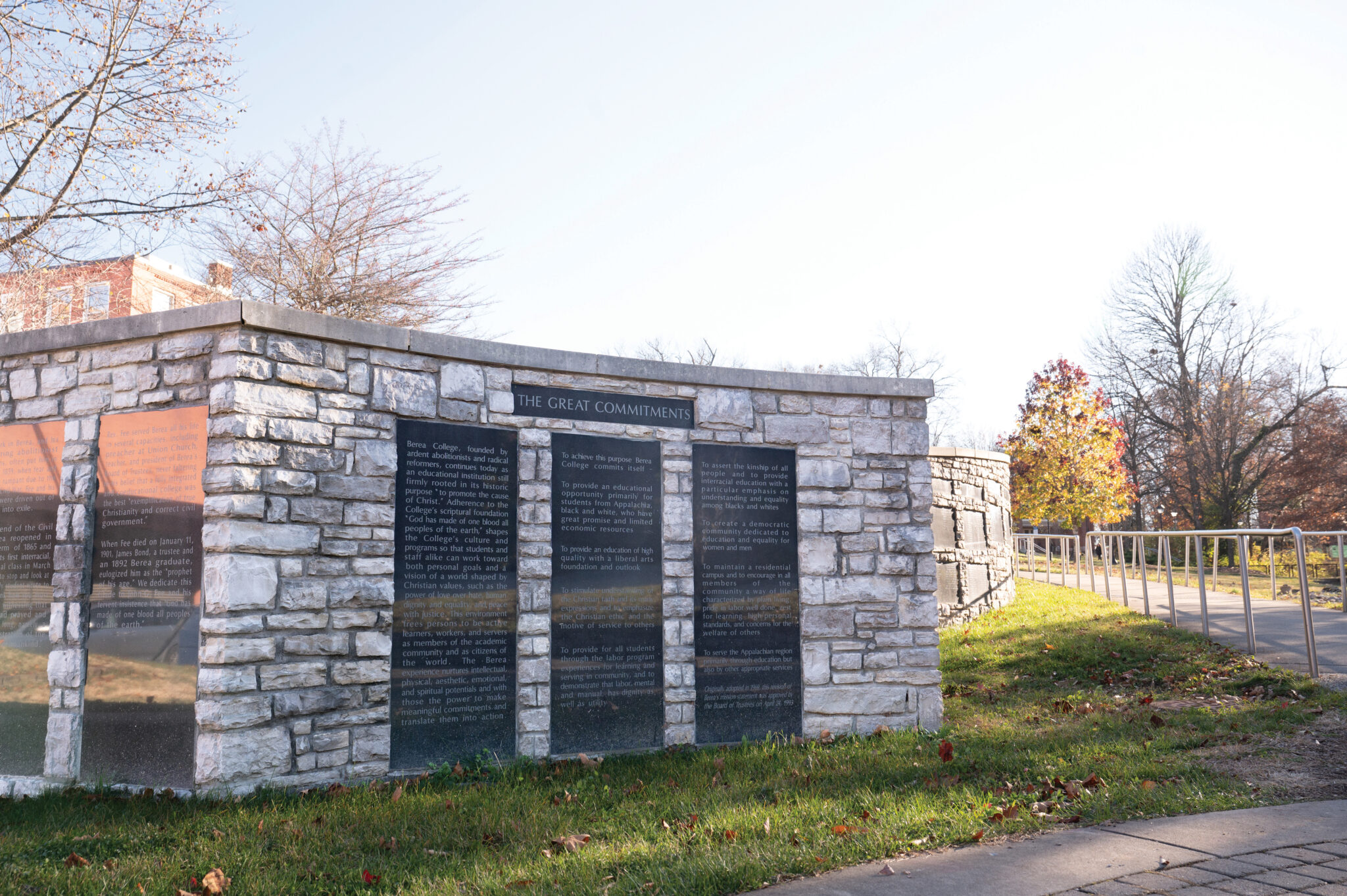Any new employee of Berea College will likely be handed a copy of the Great Commitments. There are eight. Collectively, they are the mission statement, what all Bereans work toward. The document lists no author, only that the Commitments were “first articulated in 1962.” It is interesting, and perhaps unusual, that the guiding language of an historic institution includes no writing credit.
Don Hudson ’65, retired associate provost, while shedding a little light on their composition, said, “Pardon me if I slip up and call them commandments.”
And they are, sort of, like commandments, though there’s no official penalty for breaking one of them. Despite that, beyond curriculum or accreditation or employee policies or bylaws or federal regulations, the Commitments represent the underlying spirit of the place, its heart, its dreamy ambition.
So where did they come from? The standard answer, as revealed by those in the know and the archives, is Louis Smith, who served as dean of the faculty around the time they were developed.
In 1962, Berea College President Francis Hutchins and Smith were essentially the Old Guard. The world had changed, and as they eyed retirement in the coming years, they reflected on what had happened in Berea’s past and discussed the College’s preservation for the future.
When Hutchins took over for his father in 1939, Berea College was still, by force of law, a whites-only institution. That changed for the better—or returned to normal—in 1950. As Berea approached its centennial celebration, the South’s first interracial college was officially reintegrated, and Hutchins endeavored to reiterate “the Berea idea” that had set the College apart from others.
Setting the school apart was top of mind in 1955 when centennial commencement speaker Robert Hutchins opined that “Berea had shown that it was possible in an age of public relations and mass production to have character.” That character, he continued, was one of “conscientious nonconformity.”
This notion that Berea was different from other schools must have been on Smith’s mind as well as he drafted a grant application to the Ford Foundation. To point out that Berea College is different, he suggested, is easy. “But to be different is not necessarily to be distinctive.” Sometimes different can mean eccentric.
But still, in an increasingly homogenous world, Berea did stand out with regard to how it approached higher education; this school did not charge tuition, implemented a required work program, believed not just in equality but the inherent kinship of people. With increasing curricular standardization, American colleges and universities moved toward uniformity and risked becoming as identical as the nation’s gas stations.
“If the College disappeared tomorrow,” Smith asked, “what would be lost?”
And the answer to that question was the, apparently orally conveyed, commitments.
“We inherit the institution [our predecessors] have built…what we usually call ‘the great commitments’ of Berea College, which have come to us from the leaders of the past….They still have great urgency.”
But until this point, those lowercase “great commitments” had not been formally summarized or articulated. They were simply embedded into the culture.
Hudson was a sophomore when Smith was composing his fated grant application. Though the commitments had not been formalized in ink or hung on campus walls anywhere, Hudson understood the values of the College, even if he was more concerned at the time with racing cars against his friend, Jack Roush ’64.
“Parts of the commitments were always there,” Hudson said. “It was
obvious to us that interracial education was important. It was just a matter of fact when I arrived. We shared space with students from other countries,
with students who were African
American. We got along extremely well. We saw each other for who we were.”
Smith, said Hudson, was a genius with words, the type of writer who composed final drafts the first go at it. One imagines, then, that sentences like “For better or worse, we know rather well what we are about” flowed rather easily from his pen. And then, of course, after consultation with Hutchins, came the historic first draft of the commitments, which set Berea College apart from all the rest:
1. To provide an educational program of high quality.
2. To have a liberal arts foundation and outlook for all aspects of the college program.
3. To emphasize throughout its program, although as a non-sectarian college, the Christian ethic and the motive of service to mankind.
4. To promote ideas of brotherhood, equality and democracy, with a particular emphasis on interracial education.
5. To provide an educational opportunity for students from Appalachia who have high ability and limited economic resources.
6. To serve primarily the Appalachian area—its people to be benefited mainly by education, but with other appropriate services as well.
Smith suggested additionally that these six commitments were written on paper, not etched into stone.
We know that new conditions require adaptions, but we do not believe that time has made our ancient good uncouth.”
Dean Louis Smith
“We know that the formulas adequate for our yesterdays may no longer be viable for tomorrow,” he wrote. “We know that new conditions require adaptions, but we do not believe that time has made our ancient good uncouth.”
Smith and Hutchins were to retire soon afterward. Before Hutchins ended his career, he handed the text of the Great Commitments to the incoming president, Willis D. Weatherford Jr., in 1967. Weatherford structured his first presidential report around the new, yet old, Berea College commitments. To become officially codified, to act as a mission statement and guiding document, they would need to be ratified by the faculty and approved by the Board of Trustees.
Hudson joined the faculty just as the new Commitments were being discussed by the governing body. Though there were questions and debate, the sense was that since the dean had “put those out there, they were policy.”
“Okay, this is what we go by,” Hudson said. “This is who we are.”
The faculty ratified the Great Commitments in September 1969, and the Board of Trustees approved them in October. The Commitments stood as they were ratified until 1993, when President John Stephenson led the college community in updating the living document that served as the distinct moral framework by which the College operated.
Faculty and staff in the early 1990s tweaked the language to be more inclusive, more explicit and more complete. The new version corrected the oversight that left out Berea’s historic commitment to gender equality. The total number of commitments became eight, and they added a preamble.
For decades thereafter, it was tradition that the Commitments would not be enumerated so that one would not be considered more important than another and that they be displayed in their entirety with the preamble. When Lyle Roelofs became president, he established the Great Committees, a campus-wide symposium of faculty and staff to explore the Commitments and determine if they needed to be updated to reflect the modern world. With but a few tweaks, the newest version of the Great Commitments was posted in 2017.
So, then, who wrote the Great Commitments? The driving question of this piece expects to find the name of a particular author. While the man who wrote them down was easily identified from the archives, the true answer to the question is: Everybody.


